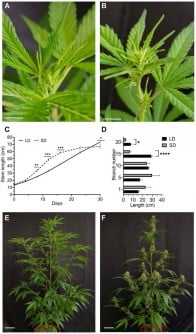Research from the Volcani Institute in Israel has revealed critical hormonal mechanisms that govern the flowering process of cannabis, specifically Cannabis sativa L.. Published on September 3, 2024, in the journal Horticulture Research, this study provides new insights into how light exposure and hormone levels affect the shape and density of cannabis flowers, which are essential for both medical and recreational use.
The development of female flowers is crucial, as it directly influences the yield and concentration of bioactive compounds like THC and CBD. Previous studies established that early flowering occurs independently of photoperiod, but the full maturation process remained poorly understood. According to the research team, gibberellins—a group of plant hormones—play a significant but previously unclear role in cannabis flowering.
By conducting experiments that combined light cycle variations with hormone treatments, researchers found that short-day (SD) photoperiods are essential for initiating and sustaining the development of inflorescences. Specifically, they discovered that maintaining low levels of gibberellins is vital for compact flower cluster formation. When light conditions were reversed or gibberellins were applied externally, the balance was disrupted, resulting in elongated stems and sparse flowers.
Key Findings on Flower Development
The study demonstrated a two-phase response to short-day lighting in mature cannabis plants. Initially, plants experience a growth surge characterized by rapid stem elongation. However, by day 10 of exposure to SD conditions, stem elongation ceases, and compact flower clusters begin to form. This transition correlates with decreasing levels of gibberellin (specifically GA4) and auxin in the shoot apex.
Researchers noted that just three days of SD exposure were sufficient to trigger the initiation of inflorescence, but continuous SD was required to maintain it. Switching back to long-day (LD) conditions restored hormone levels, reversed floral clustering, and prompted a return to vegetative growth. Additionally, the application of exogenous gibberellin during SD conditions replicated the effects of LD exposure, further indicating its pivotal role in affecting flower development and cannabinoid production.
Dr. Ben Spitzer-Rimon, the lead author of the study, emphasized the implications of these findings: “Cannabis inflorescence development is a reversible, hormone-dependent process that requires a precise photoperiod. Our results show that even after flowers begin to form, returning to long days or increasing gibberellin levels can dismantle the process.” This insight could significantly enhance how cannabis is cultivated, leading to more predictable and efficient production methods.
Implications for Cannabis Cultivation
The findings of this research carry substantial implications for commercial cannabis cultivation. Understanding that continuous short-day lighting is necessary to maintain flower clusters equips growers with a powerful tool for precise timing in flowering stages. This knowledge can help avoid disruptions that may compromise the quality of the final product.
Moreover, manipulating gibberellin levels presents a novel approach to controlling plant architecture and potentially enhancing cannabinoid yields. For the pharmaceutical industry, where the density of flowers and chemical consistency are paramount, this study offers a hormonal roadmap for optimizing production processes.
As the cannabis sector expands globally, insights from this research will be crucial in refining cultivation protocols and breeding strategies. The collaboration with Canndoc Ltd, a certified commercial cultivation producer in Israel, underscores the practical applications of these findings in real-world settings.
This study not only enhances scientific understanding but also provides actionable strategies for growers aiming to maximize the quality and potency of cannabis products in an increasingly competitive market.
